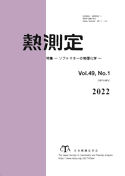All issues

Volume 41 (2014)
- Issue 4 Pages 129-
- Issue 3 Pages 93-
- Issue 2 Pages 43-
- Issue 1 Pages 1-
Volume 41, Issue 4
Displaying 1-5 of 5 articles from this issue
- |<
- <
- 1
- >
- >|
Preface
-
Hirohisa Yoshida2014 Volume 41 Issue 4 Pages 129-130
Published: November 30, 2014
Released on J-STAGE: November 20, 2022
JOURNAL FREE ACCESSDownload PDF (599K)
Special Issue - The 50th Anniversary of the JCCTA; The 40th Anniversary of the JSCTA -
-
Retrospection of the 50th Anniversary of the Japanese Conference on Calorimetry and Thermal AnalysisMichio Sorai2014 Volume 41 Issue 4 Pages 131-140
Published: November 30, 2014
Released on J-STAGE: November 20, 2022
JOURNAL FREE ACCESSThe Japan Society of Calorimetry and Thermal Analysis (JSCTA) celebrates this year the 50th anniversary of the Japanese Conference on Calorimetry and Thermal Analysis (JCCTA). The first annual conference was organized in 1965 by the late Prof. Syûzô Seki. In those days, important conferences and associations were established such as “International Conference on Chemical Thermodynamics (ICCT)” by IUPAC, “Calorimetry Conference (CALCON)” in North America, “All Union Conference on Calorimetry” in Soviet Union, “Experimental Thermodynamics Conference” in UK, the first conference of the “International Confederation for Thermal Analysis (ICTA)”, “North American Thermal Analysis Society (NATAS)”,”Association Française de Calorimétrie et Analyse Thermique (AFCAT)”, “Gesellschaft für Thermische Analyse, e.V. (GEFTA)” in Germany, and so on. One of the characteristic aspects of JSCTA is excellent collaborations between calorimetry and thermal analysis. It is admirable that today's prosperities of the society and the conference have been accomplished by every endeavor of all the members since the foundation of the society. As the period of fifty years is actually very long, a lot of members don’t know how this society was founded and what history both the society and the conference have had. Their histories are described chronologically. I hope that this retrospection will contribute to the future development of the society.View full abstractDownload PDF (950K) -
Kazuya Saito2014 Volume 41 Issue 4 Pages 141-147
Published: November 30, 2014
Released on J-STAGE: November 20, 2022
JOURNAL FREE ACCESSOn the occasion of the 50th anniversary of the Japanese Conference on Calorimetry and Thermal Analysis(JCCTA), the annual meeting of the Japan Society of Calorimetry and Thermal Analysis, personal perspective towardthe fruitful future of thermodynamic study of materials is presented, while targeting young people working in the field.After a brief review on the principal nature and recent progress of basic thermodynamics, the present status ofexperimental thermodynamics is discussed. The latter half of the manuscript is devoted to the introduction of author’sown works, detecting motional correlation in crystals through entropy and seeking the basic structure of layered liquidcrystals based on the knowledge of molecular dynamics, which he believe to contain, as examples, some componentsvaluable for fruitful future of thermal study of materials.View full abstractDownload PDF (542K) -
Junko Morikawa2014 Volume 41 Issue 4 Pages 148-151
Published: November 30, 2014
Released on J-STAGE: November 20, 2022
JOURNAL FREE ACCESSInfrared (IR) cameras have been used to visualize the thermal image in IR wavelength. IR sensors are assembledinto focal–plane arrays (FPAs) and categorized in the photon (InSb, MCT) and thermal (pyroelectric or ferroelectriccrystals, amorphous silicon, VOx) detectors. The photon detectors are superior in speed and sensitivity in thermal andlong IR wavelength (LWIR), and microscale thermography has been usually operated with InSb detectors combinedwith the optical lens design optimized for 3 micro-m to 5 micro-m wavelengths. However, the photon detector must be cooled byliquid nitrogen or a Stirling cycle cooler in order to get the high-quality image with high sensitivity and low noise. It iscostly, and a cooling device takes a space. Recently, the performance of thermal detectors, as called micro-bolometers,has been developed with a smaller pixel pitch and larger pixel numbers of FPA, obtaining Noise EquivalentTemperature Difference (NETD) 50 mK and pixel size 17 micro-m, with reducing the cost. It is attractive to the micro-scalethermography, if the time response is improved, and the micro-lens is optimized for the wavelength ofmicro-bolometers, to realize a concept of a common and wide use apparatus for a high-quality thermal imaging. Inorder to realize the mobile type quantitative microscale thermography apparatus using a micro-bolometer, thefollowing idea is proposed; an achromatic lens design for a micro-scale image, a video signal superimposed for the realtime emissivity correction, and a pseudo acceleration of a timeframe. The total size of the instrument is designed as itis put in the 17 cm x 28 cm x 26 cm size carrying box. We have developed a quantitative microscale thermal imagingsystem that can be used as a portable instrument. Our apparatus has the potential to improve the spatial and timeresolutions of uncooled IR cameras. We are now planning to make our instrument design for the general purposes inthermal characterization of materials, with energy transport and storage applications. We are targeting spectroscopicand 3D thermal imaging for the next generation of our technology.View full abstractDownload PDF (693K) -
Minoru Hanaya, Kazuya Saito2014 Volume 41 Issue 4 Pages 152-157
Published: November 30, 2014
Released on J-STAGE: November 20, 2022
JOURNAL FREE ACCESSThe 50 years’ history of the Japanese Conference on Calorimetry and Thermal Analysis (JCCTA), the annualmeeting of the Japan Society of Calorimetry and Thermal Analysis (JSCTA), is briefly described on the basis of thestatistics. Some characteristics are pointed out and discussed in relation to its birth and growth while paying attentionson the covered topics.View full abstractDownload PDF (1320K)
- |<
- <
- 1
- >
- >|